2024 Aston Martin DB12 flaunts power poise and prowess
CarNews
Mediterranean to the left, the cliffside village of Roquebrune to the right—from this vantage point I have a birds-eye view of the principality of Monaco, its ancient walls, a dozen clay tennis courts where who knows, maybe Roger Federer has played, even the corners of the F1 street circuit. It’s not often you get to look down upon the citizens of Monaco—royal family included—or to watch Lamborghinis fumble for the correct gear when parading down the mountainside, eager for attention.
The Aston Martin DB12 doesn’t need to flaunt itself like that. It already lives in the heads of so many ultra-luxury brands that try to mimic its effortless chic or the of-a-piece feel of its performance. Many are quicker, most are flashier, but few hit the cachet nail square on its head.
The DB12 is the latest in a long line of DB-badged grand tourers. The new car marks 75 years since David Brown, whose initials are the basis of the DB naming strategy, helped rescue Aston Martin after World War II and launched the 2-Liter, which later became to be known as the DB1.
While other automakers have pitched themselves headlong into electrification and EVs, Aston Martin is preparing its own pivot, with new leadership, new funding, new partnerships (it’s now a part-owner of American EV maker Lucid), and a focus on maintaining its mystique and heritage while it reinvents itself, one more time. The DB12 sets its sights on luring in drivers with panache and power as it straddles automotive eras, the one it fondly recalls and the one it sees coming in its rearview mirror.
Aston Martin DB12: sensational style
The direct successor of the DB11 launched seven years ago, the Aston DB12 marks more of a heavy update than a full redesign. According to designer Marek Reichman, its more pronounced front end looks like a fist moving through the air. Aggression keeps coming up as a theme, as Aston execs praise the success of Lamborghini in laying out with ruthless efficiency what its drivers want and sticking to it, without much change.
Much of the DB11’s original shape carries over, with some refinement, but that new front end brings a sense of power and potency to the car’s shape that it had backpedaled. A much larger grille adorns the front end, and deep strakes claw down it, elongating the nose and filing the air into channels as it streaks down the road. The headlights have matrix-LED technology and hook down more deeply into the front end like pincers.
The track is also wider front and rear, up 6 and 22 mm, respectively. The wasp-waisted shape has grown more pinched at its torso, and its haunches seem athletically enormous now; it’s a foot and a half across the top of the fender, measured from the taper of the cat-eye trim to the edge of the metal. The very spare look of the DB12’s rear end wears thin LED splines for taillights, which give breathing room for an enamel badge and name.
Fabulous seats with perforated and quilted leather and cooling greet the driver and passenger inside the DB12. Power controls for the seats lie on the side of the console, while the console itself presents a panel of switches for everything from active exhaust and damper control to roller controllers for fan and temperature and volume. The transmission’s a stubby nubbin stitched with coordinating leather dyed in shades from uncontroversial beige to an attractive aubergine.
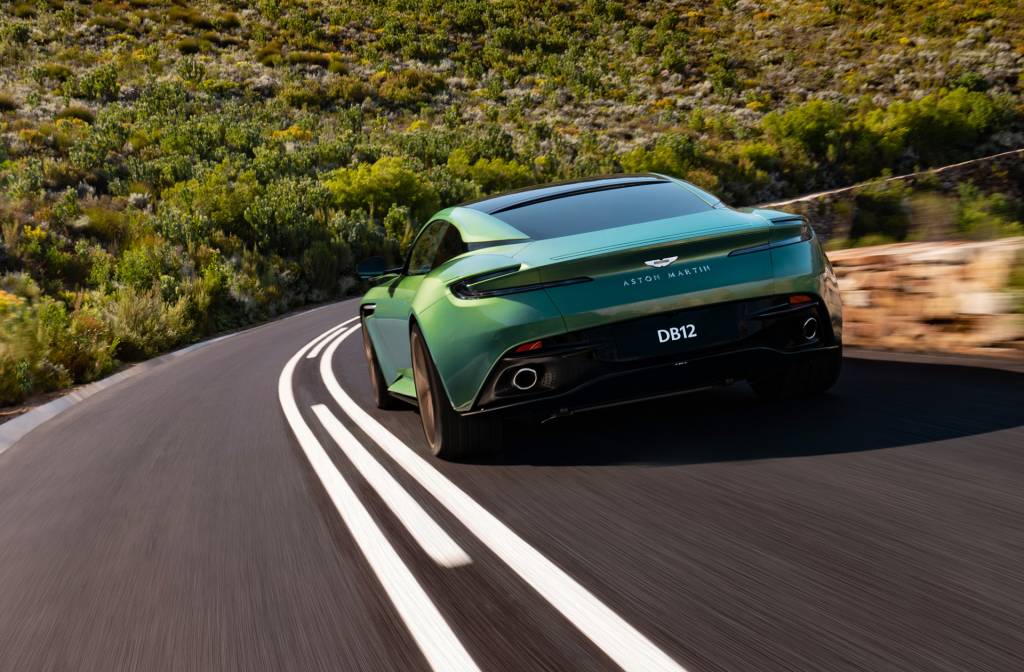
Aston Martin DB12
Aston Martin DB12: soaring to 671 hp
Press the center of the knob above that toggle, and the DB12’s twin-turbo V-8 chugs to life. Four years ago it made 503 hp in the DB11 V-8; now it’s much stronger. The Aston-infused Benz twin-turbo 4.0-liter V-8 breathes out 671 hp, about 40 hp more than the 5.2-liter turbo V-12 from the DB11. The V-8 weighs about 220 pounds less as well.
Some of the power differences between the old and the new V-8 include new cam profiles, bigger turbos, and a 13-percent shorter final-drive ratio for its 8-speed automatic transmission. Aston Martin says the revamped drivetrain catapults the DB12 to 60 mph in 3.6 seconds, down 0.4 second from the DB11’s best numbers; top speed now clicks in at 202 mph, according to the manufacturer.
No thanks, I mutter, as I swear off any top-speed runs. The glaring spotlight of French speed cameras already has me pegged on the way to the Provence hinterlands.
The drivetrain’s joyous noises have a sharper bark than even Aston’s highly tuned V-12s from other vehicles—but the signature piece here might be the drive modes, which have been programmed to widen the range of throttle and transmission responses. A relaxed cruiser in its default GT mode, the DB12 gets the hint when it’s spun to Sport or better yet, Sport+, where it’s quicker to respond to small throttle inputs, and faster to swap down a gear or three through the rear-mounted automatic. The big silver shift paddles on the backside of the DB12’s steering wheel encourage rifling through gears, while its electronic rear differential ensures power flows to the rear wheels without undue wheelspin.
The raspy, whizzy sounds that get muted by thick glass and heavy carpet and leather need to find their way into the DB12 cockpit somehow, so Aston has taken the amplified the exhaust noise; it pumps into the cabin at all speeds, varying in levels based on the drive mode selected. In Sport+, the fluffed-up exhaust fills the cabin with guffles and maws that crackle with energy, even as the DB12 settles into an unruffled triple-digit clip.
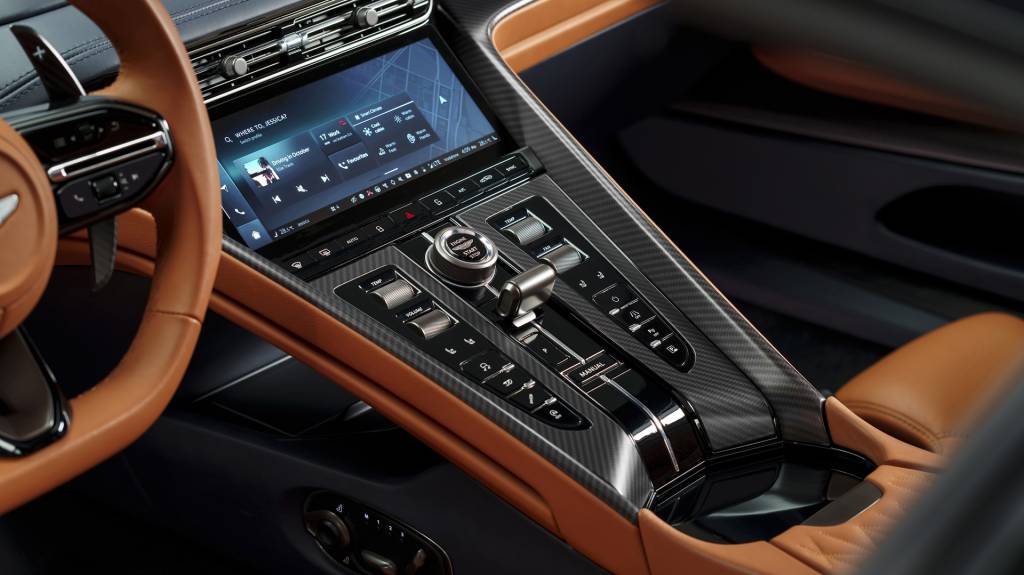
Aston Martin DB12
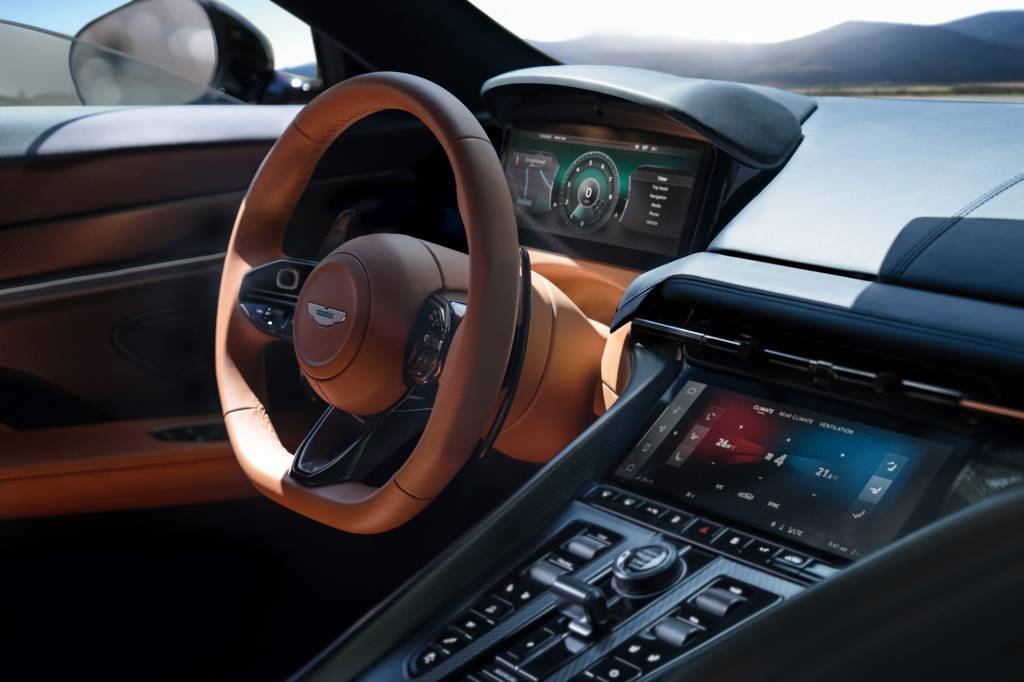
Aston Martin DB12
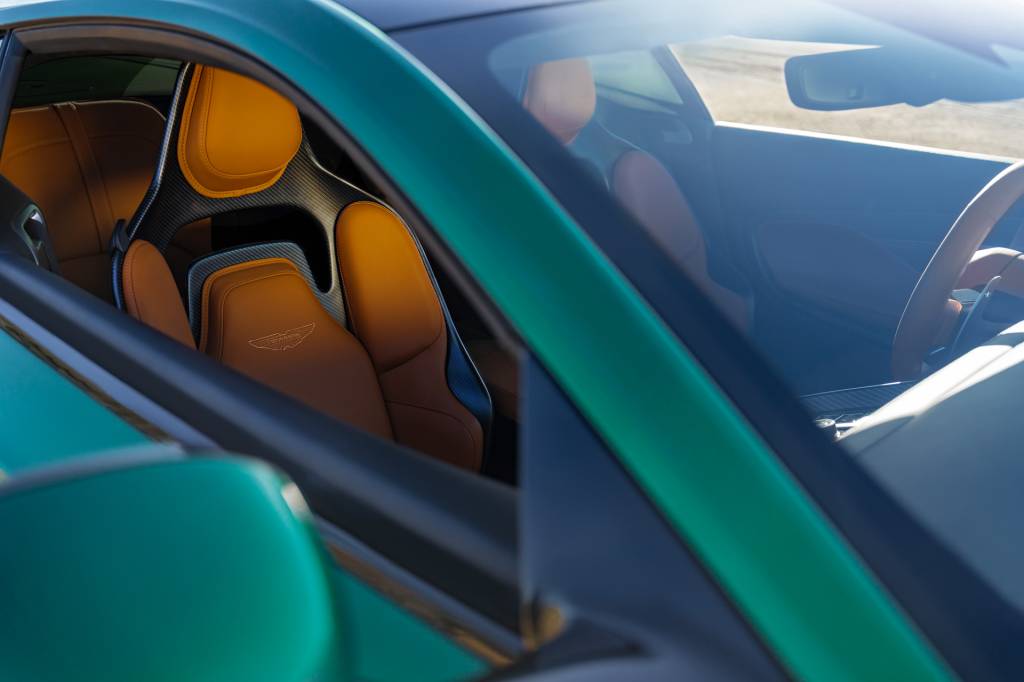
Aston Martin DB12
Aston Martin DB12: Crisper ride and handling
Aston revamped the DB’s chassis as it nudged it from 11 to 12—we assume with Christopher Guest’s approval. Engineers fitted stiffer anti-roll bars and adjustable dampers while remapping the car’s electronic power steering and adjustable electronic stability control systems, all in the name of softening the car’s attitude in its comfort-oriented GT mode while boosting the body control and responsiveness in the Sport and Sport+ modes.
Steering precision is a bright spot of the DB12, says Aston’s head of vehicle integration, Simon Newton. He’s on to something: it’s a big car that must be threaded carefully through the narrow canyon roads that lead up and away from Monaco, but the spring and damping choices in combination with bigger 21-inch wheels (0.9 inch wider than before) provide better, cleaner output from any degree of steering input than in the DB11. New Michelin Pilot Sport S 5 tires, measuring 275/35 up front and a meaty 315/30 at the rear, have much to do with its agreeable steering, as do lighter wheel designs.
Faster processors and accelerometers get the credit for the chassis’ better performance. The car’s simply quicker to generate information about the road and to respond to it through its dampers, and it’s capable of clipping through the French countryside at speeds that register it all as a blurred panorama. Carbon-ceramic brakes can haul the DB12 to a stop more quickly and with a lighter footprint, but the stock brakes check in at nearly 16 inches across in front, with grooved and drilled faces for better thermal management.
Still, the DB12 is a tightly sprung car, and in GT mode it delivers a ride that’s more firm than ever, crossing the divide between grand tourer and what Aston dubs a new category: the DB12 is a “super tourer,” they believe. It can deliver up to 28% more lateral grip, but the trade-off comes in some low-speed wheel motion the dampers can’t erase. To adapt it for my own personal preferences, I set the DB12 in GT suspension mode, but select Sport+ for the drivetrain and steering. The latter, especially, suits the new car’s character, as it drops the slower-shifting pettifoggery for slack-free corner attacks. It’s all in concert; the powertrain isn’t wildly out of character for the ride and handling tune, and vice versa, though it’s distinctly stiffer.
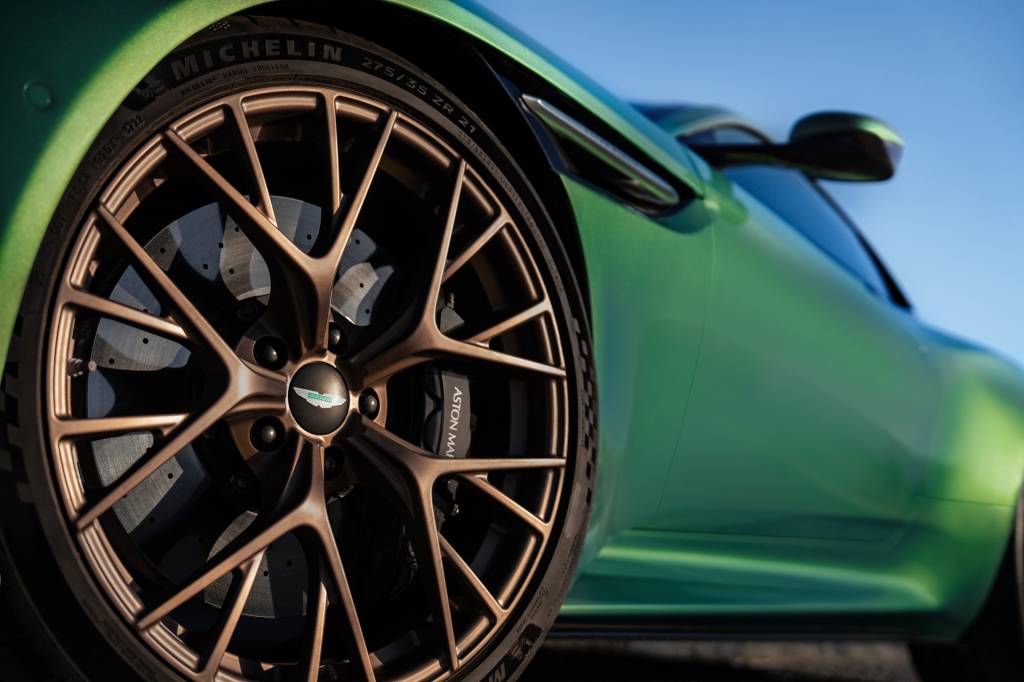
Aston Martin DB12
Aston Martin DB12: The next step toward Valhalla
On the longer stretches of the drive back toward Monaco, the DB12’s fab interior delivered the usual sensual buffet of delights, with its supple front bucket seats stitched like handmade handbags. Its teensy rear seat and trunk merely hint at utility; they’re not serious spaces for the hard work of transportation, unless that hard work involves an Hermès backpack and a quick shuttle to the beach.
The most important change in the DB12 interior is the latest infotainment system, which Aston Martin developed. A wide touchscreen delivers over-the-air updates as well as Android Auto and Apple CarPlay, and integrates better into the cleanly styled interior. The cabin’s decked out with a knurled rotary drive selector—the start button lives in it—and carbon fiber trims the cabin in tandem with hand-stitched Bridge of Weir leather or Alcantara. An 11-speaker audio system can be upgraded to a sharp-sounding 15-speaker Bowers & Wilkins setup.
Driver-assist features include automatic emergency braking, active lane control, blind-spot monitors with cross-traffic warnings, and traffic sign recognition. A surround-view camera system comes with every DB12.
The DB12 comes to the U.S. later this year; while pricing hasn’t been confirmed, it’s sure to occupy a layer of the stratosphere above the DB11, which means a pricetag likely more than $225,000. A DB12 Volante convertible no doubt is on the way.
After that, it’s truly the deluge, as Aston releases a new Vantage as well as the plug-in hybrid Valhalla supercar and an electric sports car. If all goes according to the latest plan, the brand will have a fuller portfolio including both EVs and hybrids, SUVs and supercars among them, by the end of the decade.
That’s for the future. In the present, the DB12 takes its spot high above Monaco, where its vibe syncs in perfectly with that of the Mediterranean just beginning to bathe in summer. I see the clay courts again—then I realize we haven’t been looking down on the citizens of Monaco. All this time, behind the wheel of the DB12, we’ve been giving them a reason to look up.
Aston Martin paid for travel expenses that enabled this review.







